Five High Profile Rules Incidents of 2024
A look at five rules incidents that took place on the professional tours through 2024. David Wilson, Rules Manager at The R&A explains what happened in each case.
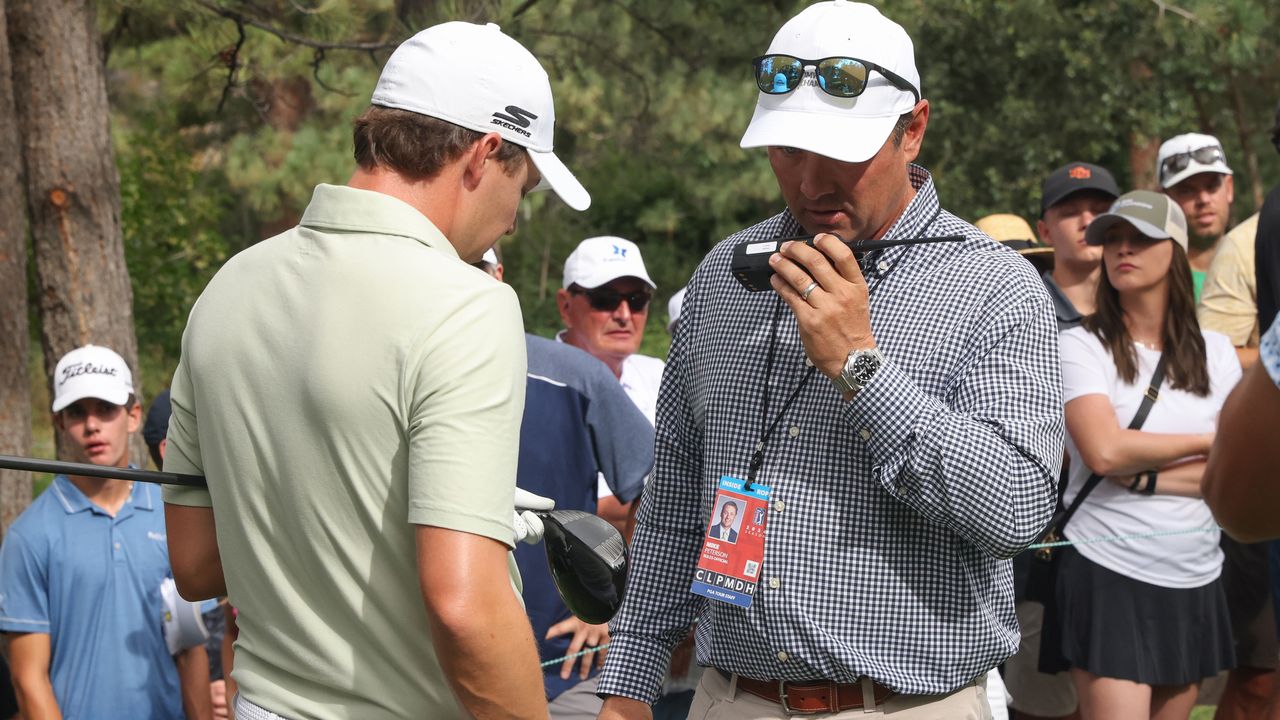

In every professional tournament, there are numerous situations where rulings are required. Free drops from sprinkler heads, line of sight relief from Temporary Immovable Obstructions, a ball coming to rest in a spectator’s sandwich… those sorts of things.
Tournament referees earn their crust. Buzzing about the course, solving Rules conundrums for players competing for significant prize money. It’s a vital job and it’s essential the officials get it right to ensure the tournament playing field is fair and level.
There are a huge number of scenarios that can arise on the golf course, and both players and Rules officials must be ready and knowledgeable enough to deal with some unusual ones. Here, David Wilson, Rules Manager at The R&A looks at five high profile Rules incidents of 2024 that had players scratching their heads. Thankfully, in each one, trained Rules experts were on hand to point them in the right direction.
Original Ball Found, But Not By Player – Shane Lowry
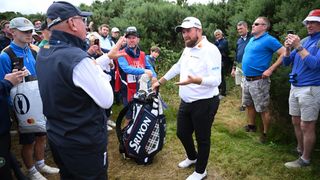
Shane wasn't too happy with the ruling...
The 152nd Open – Day Two
An experience many of us can relate to is hitting our golf ball offline and towards the bushes, and to then to follow up by a hitting a provisional ball straight into the middle of the fairway or green.
And this is just what happened to Shane Lowry on the 11th hole at Royal Troon on day two of the 152nd Open Championship. Lowry’s second shot headed left out of the thick grass into the gorse bushes lining the left side of the hole, so he played a provisional ball which was struck onto the green. Following the fine approach with his provisional, Lowry wished to proceed with the provisional ball and attempt a putt for a would-be bogey, however a spectator had already found a ball in the bushes in the area where his original ball may lie. And the Rules are very specific in what must happen in this scenario.
The original ball is still in play because the second ball has been played as a provisional ball; essentially in case the first ball is lost. And as a ball has been found in the area of the original ball, and irrespective of by whom, the player must identify it. If it is the player’s ball, then they must proceed with the original ball and the provisional becomes obsolete, just as it did for Lowry. This led to the taking of an unplayable ball, choosing back-on-the-line relief and eventually finishing the hole with a double bogey 6.
Get the Golf Monthly Newsletter
Subscribe to the Golf Monthly newsletter to stay up to date with all the latest tour news, equipment news, reviews, head-to-heads and buyer’s guides from our team of experienced experts.
However, if the ball found was not the original ball, then the player can continue with the three-minute search or elect to proceed with playing the provisional ball, so long as no other ball is found within the three minutes in the area of the original. And if the provisional ball is played from closer to the hole than the estimated spot of the original ball, then that becomes the ball in play.
As a golfer, it’s your actions that determine which ball is in play; for example you do not need to exhaust a three minute search if you do not wish to find the original ball and, instead, continue play of the hole with your provisional ball. But the provisional ball only becomes the ball in play when you play your next stroke, not when you publicly claim the original is lost or you do not wish to find it.
Ball As Possible Backstop – Billy Horschel
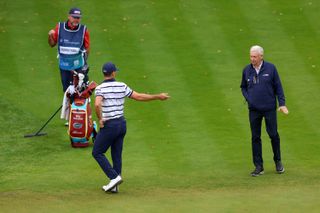
Billy Horschel talks to a Rules official
BMW PGA Championship 2024 – Final Day
The BMW Championship at Wentworth is always a highlight of the golfing calendar, and the 2024 offering was no exception. Thriston Lawrence, Rory McIlroy and Billy Horschel all tied at 20-under-par, leading to a playoff to find the champion. Which included an interesting ruling.
After Lawrence played his approach shot, his ball finished around four feet from the hole. For Horschel’s upcoming bunker shot, the ball was in a position almost directly behind the cup, close to the water. Under the Rules a player who reasonably believes that a ball at rest on the putting green might help anyone’s play, for example by serving as a possible backstop, they can require the ball to be marked and lifted. The walking Rules Official, following an approach from McIlroy, asked Horschel to refrain from playing until the ball had been marked, as there was a good chance the ball remaining in position on the putting green could help his play. This was a good example of preventing a potential backstopping issue occurring prior to Horschel playing his bunker shot.
A ball or ball marker helping with play on the putting green is a relatively common occurrence many of us encounter. When this arises in stroke play, and there is a situation where a ball might help the play of another player, there must not be an agreement between two or more players for that ball to be left in place. If this does occur and the player makes a stroke, then each player involved in the agreement receives the general penalty. The ball must either be marked and lifted, or the player who is required to mark and lift may play first if they wish to do so.
There are also situations where a ball or ball-marker is interfering with play. If a player believes that another player’s ball anywhere on the course might interfere with their play, then they can require the other player to mark and lift their ball (however, the lifted ball must not be cleaned), and replace it following the stroke. For a ball marker, the process is to move or require the ball-marker to be moved out of the way to a new spot measured from its original spot, such as the length of a putter head, and then the process reversed to return the ball-marker to the original position.
Irretrievable Ball In Immovable Obstruction - Akshay Bhatia

Akshay Bhatia talks to a Rules official
Rocket Mortgage Classic - Round Two
On rare occasions, a perfectly struck drive on the golf course, heading down the middle of the fairway, might not come to rest on the short grass. But the Rules do consider a number of these unusual scenarios that can occur.
So when Akshay Bhatia’s tee shot was fired down the middle of the 17th fairway at the Rocket Mortgage Classic and rolled into a hole in the fairway drainage system, he called a rules official over for assistance. Bhatia’s ball was in the drain. It, by definition, is an Immovable Obstruction, which is defined as an Abnormal Course Condition under the Rules from which free relief is permitted. The rules official identified the reference point for free relief, this being a few inches to the right-hand side from the drain cover on the fairway, as he was playing the hole. This was because Akshay is a left-handed player, and when ascertaining the nearest point of complete relief there must be no interference for the player’s stance as well as none for lie of ball and area of intended swing. Akshay then had a one club-length relief area, not nearer the hole, from the reference point in which to drop a ball, where there would be no interference from the drain.
Akshay’s ball was irretrievable having fallen in the drain, but he was able to substitute his original ball regardless. Whenever you are required to drop a ball under the Rules, you may drop the original ball or substitute it for another. Therefore, there was no requirement for the drain cover to be removed to retrieve the original ball. Instead, Akshay could simply drop another ball within his relief area and continue play of the hole.
On this occasion, Akshay was able to find his original ball, but this may not always be the case. However, the Rules once again do account for these scenarios. If it is known or virtually certain that the player’s ball has been lost in an abnormal course condition, the player may take free relief using the estimated point where the ball last crossed the edge of the abnormal course condition as the spot from which the nearest point of complete relief is obtained.
Ball on Bridge Over Penalty Area – Miguel Angel Martin
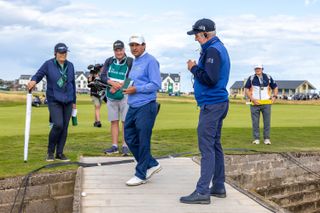
Miguel Angel Martin talks to a Rules official
The Senior Open presented by Rolex 2024 – Day Three
Carnoustie’s Barry Burn is certainly one of the more famous penalty areas in golf; many of us can think of some iconic moments in golf over the years involving the waterway. The Senior Open in 2024 added yet more incident, but this time the bridge on the 17th hole was involved.
Miguel Angel Martin found his ball had come to rest on the bridge crossing the penalty area, and asked for Rules support from the referee team. However, there is no free relief available in this situation and the referees correctly informed Martin that he had to either to play the ball as it lied (which he did,) or proceed under the options for penalty relief for a red penalty area.
This is because free relief from an abnormal course condition, including immovable obstructions, which in this instance is the bridge, is not allowed if the ball is in a penalty area.
And although the ball is not touching, nor is in the water itself, edges of penalty areas extend up above and down below the ground, meaning that all ground and anything else inside the edges of the penalty area whether on, above or below the surface of the ground are in the penalty area. Therefore, the ball was in the penalty area. When playing a ball from a penalty area, the same Rules apply to a ball in the general area so it is permissible to take a practice swing or ground the club, for example.
If we think logically, the burn has not stopped flowing because the bridge has been built, and similarly if the bridge was not there the ball would have been at rest in the Barry Burn. If it was not for the need to cross the water, the bridge would not exist. It is a minor lucky break that Martin could play that ball as it lies and advance it a reasonable distance up the hole, but to receive free relief from the bridge in addition would have been a huge stroke of fortune. Martin did indeed take advantage of his minor break and played the ball from the bridge and finished the Championship in a tie for 5th position.
Club Damaged During Play – Matt Fitzpatrick
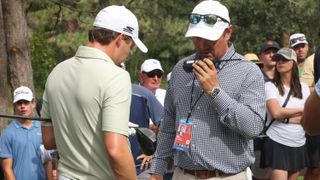
Matt Fitzpatrick chats with a Rules official
BMW Championship – Final Day
Although it’s not something we experience every time we step onto the golf course, from time to time our clubs do suffer damage which can affect how they perform.
There are a number of different ways in which a club can be damaged during the round, but an option which is always available, regardless of how the club was damaged, is to continue using it for the remainder of that round. So, if the clubhead is deformed as a result of striking the ball, or even if you bend or break the shaft following abuse of a moment of anger you can continue to use that club; it is deemed as conforming for the remainder of the round.
If the club is damaged not as a result of abuse, but perhaps through normal play or simply an accident, then there are two other options available. The first is to try and repair the club. In some instances this would be extremely difficult, but perhaps the most common would be to tighten the clubhead of a club with an adjustable mechanism, provided the club is not being adjusted to a different setting. The second option available is to replace the damaged club with another club. If this option is chosen there is no restriction on which club is used as a replacement, but the process must not unreasonably delay play and you cannot borrow any club being carried by another player on the golf course.
However, the Rules on professional Tours often differ slightly courtesy of Local Rules which are in place. So when Matt Fitzpatrick noticed a small crack in his clubface during the final round of the BMW Championship in Colorado, he called for a Referee. The Local Rule in place states that a club needs to be “broken or significantly damaged,” and that a club is not broken or significantly damaged if there is solely a crack in the club face or clubhead. If solely a crack, the player cannot replace the club during the round. This was the assessment made by the Referee in this case. While there was a hairline crack visible, there was no separation felt by the fingers in the metals around the crack. Therefore, Matt Fitzpatrick was advised that he could continue to use the driver, but not replace it.

Fergus is Golf Monthly's resident expert on the history of the game and has written extensively on that subject. He has also worked with Golf Monthly to produce a podcast series. Called 18 Majors: The Golf History Show it offers new and in-depth perspectives on some of the most important moments in golf's long history. You can find all the details about it here.
He is a golf obsessive and 1-handicapper. Growing up in the North East of Scotland, golf runs through his veins and his passion for the sport was bolstered during his time at St Andrews university studying history. He went on to earn a post graduate diploma from the London School of Journalism. Fergus has worked for Golf Monthly since 2004 and has written two books on the game; "Great Golf Debates" together with Jezz Ellwood of Golf Monthly and the history section of "The Ultimate Golf Book" together with Neil Tappin , also of Golf Monthly.
Fergus once shanked a ball from just over Granny Clark's Wynd on the 18th of the Old Course that struck the St Andrews Golf Club and rebounded into the Valley of Sin, from where he saved par. Who says there's no golfing god?
-
 Creator Classic Scores: Golf Influencers Take On TPC Sawgrass Ahead Of The Players
Creator Classic Scores: Golf Influencers Take On TPC Sawgrass Ahead Of The PlayersTen big-name golf creators are on course at TPC Sawgrass ahead of The Players Championship
By Elliott Heath Last updated
-
 Charley Hull And Georgia Hall March Into Sunningdale Foursomes Last 16
Charley Hull And Georgia Hall March Into Sunningdale Foursomes Last 16The LPGA Tour pair comfortably won both of their matches on day two of the prestigious event and look like the team to beat heading into the last 16
By Jonny Leighfield Published